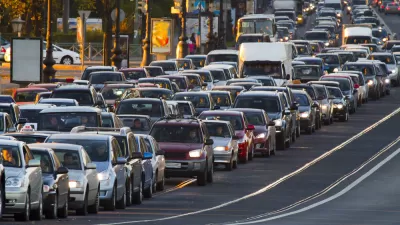The University of Michigan Transportation Research Institute released its eighth report on peak motorization in the U.S., an evaluation of time spent traveling for a broad category of purposes, not just work. From 2004 to 2014, total time decreased.

If you were to take at face value the August 26 Urban Mobility Scorecard prepared by the Texas A&M Transportation Institute (TTI) and INRIX, you'd believe that congestion is worsening throughout the United States, and a good reason to lay more asphalt. Of course, as Planetizen blogger Todd Litman explains here and here, that's hardly the case.
The supposed congestion plaguing American cities also belies the findings of the "Peak Motorization" report from the University of Michigan Transportation Research Institute (UMTRI) released September 1. This report evaluated how much time we spent traveling.
Researcher Michael Sivak evaluates two years only: 2004, the year he previously determined had the highest vehicle miles traveled per capita [PDF], and 2014, the latest year for which data is available from the American Time Use Survey prepared by the Bureau of Labor Statistics—"a representative nationwide survey of how, where, and with whom Americans spend their time."
The tables report trip times for ten categories of trips—for eating, education, work, etc., far different than the one category evaluated by TTI. From the report:
Activities for which average travel time decreased included eating and drinking (from 0.13 hours to 0.10 hours), purchasing goods and services (from 0.30 hours to 0.27 hours), caring for and helping nonhousehold members (from 0.08 hours to 0.05 hours), work (from 0.28 hours to 0.27 hours), education (from 0.04 hours to 0.03 hours), and leisure and sports (from 0.23 hours to 0.21 hours). (These values are for men and women combined.)
"The main implications of the present results are that the total travel time per person decreased substantially from 2004 to 2014," Sivak concludes. However, he adds, "that this decrease is due to a decrease in the proportion of persons engaged in the trips, and not an overall reduction of the duration of the trips."
Click here for a complete list of publications from UMTRI's Sustainable Worldwide Transportation.
FULL STORY: "Has motorization in the U.S. peaked? Part 8: Travel times in 2004 and 2014" [PDF]

Planetizen Federal Action Tracker
A weekly monitor of how Trump’s orders and actions are impacting planners and planning in America.

Congressman Proposes Bill to Rename DC Metro “Trump Train”
The Make Autorail Great Again Act would withhold federal funding to the system until the Washington Metropolitan Area Transit Authority (WMATA), rebrands as the Washington Metropolitan Authority for Greater Access (WMAGA).

DARTSpace Platform Streamlines Dallas TOD Application Process
The Dallas transit agency hopes a shorter permitting timeline will boost transit-oriented development around rail stations.

Renters Now Outnumber Homeowners in Over 200 US Suburbs
High housing costs in city centers and the new-found flexibility offered by remote work are pushing more renters to suburban areas.

The Tiny, Adorable $7,000 Car Turning Japan Onto EVs
The single seat Mibot charges from a regular plug as quickly as an iPad, and is about half the price of an average EV.

Supreme Court Ruling in Pipeline Case Guts Federal Environmental Law
The decision limits the scope of a federal law that mandates extensive environmental impact reviews of energy, infrastructure, and transportation projects.
Urban Design for Planners 1: Software Tools
This six-course series explores essential urban design concepts using open source software and equips planners with the tools they need to participate fully in the urban design process.
Planning for Universal Design
Learn the tools for implementing Universal Design in planning regulations.
Municipality of Princeton
Roanoke Valley-Alleghany Regional Commission
City of Mt Shasta
City of Camden Redevelopment Agency
City of Astoria
Transportation Research & Education Center (TREC) at Portland State University
US High Speed Rail Association
City of Camden Redevelopment Agency
Municipality of Princeton (NJ)



























